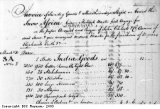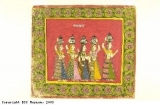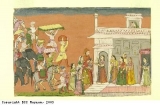Trade goods from the East: Textiles
Indian textiles were a major part of the East India Company’s trade. Hundreds of thousands of people in India were involved in the textile trade, as spinners, weavers and dyers. The cloths they made ranged from the finest muslins to heavy calicoes, some plain, some striped or checked and some hand-printed with elaborate designs. Indian cloth was used by the East India Company to trade with Indonesia. Small amounts were taken back to London and sold. The public fell in love with these new textiles, and the demand for them in Britain rose. The import of Indian textiles into Britain was so great that it threatened to destroy British silk and woollen manufactures. A new law was passed in 1700 to ban the use and wearing of Indian textiles in Britain to protect the home textile industries.
The East India Company still bought huge amounts of Indian cloth to use for trade with Africa, North America and the Caribbean. Surviving account books and business records of those involved in the transatlantic slave trade show how important Indian textiles were. They made up a large part of the trade goods of any slaving voyage. Striped and checked Indian cloth is often referred to as ‘Guinea cloth’. This was because it was the type of cloth commonly traded with the areas of West Africa known to the Europeans as Guinea. East India Company records refer to the preferences for certain types of cloth or colours and patterns in different areas of West Africa.
The slave ship the Africa from Bristol was carrying large amounts of cloth from both India and Manchester on her slaving voyages of 1774 and 1776. Shown here is the page from the ship’s accounts book which lists Indian textiles. An advertisement in the American newspaper the South Carolina Gazette for 28 May 1752 announced “Just imported in the last vessels from London and Bristol, and to be sold by Robert Pringle & Company, a very good assortment of Indian goods”. Large spotted silk handkerchiefs, known as bandannoes, were advertised for sale in Jamaican and American newspapers. These were also listed as trade goods sent by ship to the West African coast. Bhandani was the name of a tie-dyed, spotted fabric from India. Pictured here is an Indian painting of some women, their clothing includes shawls made of spotted bandhani fabric. In the Americas and Africa this was changed to bandannoes. The name bandanna is still used for large spotted handkerchiefs which can be worn around the neck or on the head.





